
|
|
|
|
 |
|
Home Site Search Contact Us Subscribe
|
|
|
|
Home Swede Home: Bo01: The City of Tomorrow Apartment Block by Moore Ruble Yudell Architects & Planners and FFNS Arkitekter
Malmö, Sweden: Technology and environmental sustainability, along with natural light, playful colors and textures, and a garden, offer a civilized setting for urban dwellers. by Kristen Richards June 4, 2002 In May 2001, Sweden
presented its first international housing exhibition (and one of the largest
ever mounted) in Malmö called
Bo01: The City of Tomorrow. It combined not only temporary exhibitions that envisioned
urban life in the future based on environmental sustainability and information
technology, but also included an actual mixed-use development called Boplatsen.
Moore Ruble Yudell Architects & Planners (MRY) from Santa Monica,
California, collaboration with Bertil Öhrström of FFNS Arkitekter AB
of Sweden, was the only American firm among many European and Scandinavian
architectural practices commissioned to design a residential city block in the
city’s new housing and office district. The site was an industrial
brownfield – formerly a SAAB automobile assembly factory. To remove the
underground pollutants, the landscape planning combines biology and
sustainability, using different species of flora that can extract the
pollutants from the ground. Ranging from two-and-half to
four-and-a-half floors in height, the building has a total gross area of 33,000
square feet on a site area of 18,228 square feet. The project houses 27 rental
apartments, from 600-square-foot studios to 1,950-square-foot, three-bedroom
units, with no floor plan repeated. One of the challenges was to
make each unit unique and still relate the entire block to the surrounding
urban fabric. This was met by developing a flexible system for articulating the
perimeter’s exterior elevations and the correlation between interior space and
exterior expression. Since the different individual units are stacked, the
potential for exterior chaos is mediated by a super-order grid that is composed
of ribbed pre-cast panels on the perimeter of the city block site. A datum of
alternating horizontal and vertical panels modulates the random placement of
windows, creating a syncopated pattern that reflects the flexible
configurations of the dwelling units from floor to floor. A contemporary reinterpretation
of the traditional board and batten construction and the louvered texture of
the panels capture and reflect the precious northern light while providing a
discreet street presence. The exterior treatment
contrasts with the vibrant, almost playful architectural expression – and
vibrant colors – of the interior courtyard facades. In this shared social
space, undulating and twisting glazed towers that vary from two to four floors
“dance” around a west-facing garden. With distant views of the Öresund Sound at
higher levels, the living room of each unit occupies part of a tower,
projecting inward to “borrow” space from the garden while making the interior
units feel more spacious. Likewise, entire walls of glass open onto the garden,
allowing the units to literally flow into the landscape. In the evening, when
their screens of fretted glass are lit from within, the glass towers glow like
a series of Chinese lanterns in the garden. The courtyard, better known
as “The Yard,” interprets the metaphor of an island wetland through its formal
design and plantings. Oriented toward the west, a central mound or “island” is
irregularly divided into distinct parts: the eastern part is an “uncultivated”
landscape of reeds, grasses, and a spiraling pool, while the western part is a
timber deck. Residents can gather, formally or informally, in this central
outdoor space, especially in the summertime. Individual footbridges above an
expanse of marshy land reminiscent of the geography and flora of the nearby Öresund
Sound, lush with grasses, reeds, bamboo, and perennials, link the residential
cores to the island. The marsh vegetation is fed by recycled rainwater through
manmade streams and a pond made of regular-cut stones and concrete, and
provides an ever-changing palette of color and texture through Malmö’s diverse seasons and light
conditions. Photovoltaic panels on the
roof provide heating and cooling for the building. Roof surfaces are also
covered with grass to restore oxygen to the atmosphere. Rainwater is recycled
and used to irrigate water gardens. Run-off water from other surfaces such as
metal panels, paving, and concrete, is directed into a perimeter channel and
then brought into a central cistern, cleaned, and returned to the ocean. All exterior windows are
triple-glazed to provide insulation; the outside layer contains transparent
Aragon gas that warms air as it passes through the layer on its way to warm the
interior. An “intelligent wall" that runs through each unit supports power
and data cabling, and orients all mechanical and technical equipment toward the
interior of the block. The project represented
Sweden at the 2001 Venice Biennale, and recently received Sweden’s 2002
Building of the Year Award. Owner: MKB
Fastighets AB, Malmö, Sweden, Lars Birve, Ingvar Carlsson Project
management: SWECO Projektledning AB, Pär Hammarberg (Project Manager), Conny
Nilsson (Assistant Project Manager /IT Coordinator) Design
Architects/Landscape Architects: Moore Ruble Yudell Architects & Planners; FFNS Arkitekter AB Executive
Architect: FFNS Arkitekter AB MRY Team:
John Ruble, FAIA (Principal Architect, Principal-in-Charge), Buzz Yudell, FAIA
(Principal architect), James Mary O’Connor (Associate-in-Charge, Project
Architect), Lisa Belian, Tony Tran (Project Team), Tina Beebe, Kaoru Orime
(Colors and Materials, Landscape Design, Interior Design/Exhibition Apartment),
Ross Morishige (Digital Renderings), Mark Grand, Chad T. Takenaka, Vely Zajec,
Don Hornbeck, Joshua Lunn, Matthew Vincent, Lance Collins (Models) SWECO FFNS
Arkitekter AB Team: Bertil Öhrström (Principal Architect), Karin Bellander,
Lars Lindahl (Project Architects), Siv Degerman (Landscape architect), Karin
Bellander, Johanna Wittenmark (Interior designers) Photographer:
Werner Huthmacher Since the
founding of Moore Ruble Yudell Architects &
Planners with
Charles Moore in 1977, principals John Ruble and Buzz Yudell have built a
varied body of work ranging from private residences to multi-million-dollar
institutional, civic, and mixed-use developments. The initial goal of Moore
Ruble Yudell was to have an intensive collaboration among the principals, with
the collaborative spirit extending to include project staff and clients. The
principals pioneered the use of client and community workshops in the design
process. Their work on a wide range of building types has given them extensive
experience working with complex client groups as well as regulatory and
governmental agencies. The firm has received numerous major awards for design
excellence. SWECO FFNS is one of the Nordic region's
largest architectural firms with services in architecture, interior
architecture, urban planning, landscape architecture, and indoor environment. FFNS Arkitekter AB was established
in 1958 by the architects Bertil Falck, Carl-Erik Fogelvik, Gunnar Nordström,
and the building engineer Erik Smas. In
1997, FFNS merged with VBB, the largest technical consultant
firm in Sweden at the time. Thus SWECO was created, a powerful combination of
technical consultants and expertise. In
2001, the name SWECO FFNS was established. Today, the firm has
a staff of 350 and offices in 15 locations throughout Sweden, and is part owner
of the Danish architectural company Skaarup & Jespersen A/S Arkitekter og
Byplanläggare, a company with a long experience in international ventures
within architecture and urban planning. Recent international
projects include Luodian Town, a new town for 25,000 people in Shanghai,
and a 120,000-square-meter mixed-use development in Beijing. Also featured on
ArchNewsNow.com (updated 04/13/04): Straight A's: Horace
Mann Elementary School by Moore Ruble Yudell San Jose, California: A student
"village" makes a good neighbor in the heart of an urban historic
district. |
(click on pictures to enlarge) 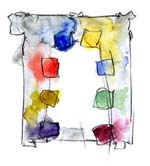 (Moore Ruble Yudell (MRY)) The conceptual sketch for a 27-unit block in Bo01, Sweden's "City of Tomorrow" in Malmö. (MRY) Site plan with block highlighted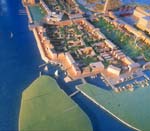 (MRY) Site model with project location indicated.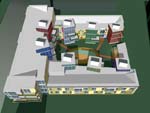 (MRY) Aerial view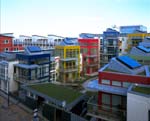 (Werner Huthmacher) A view into the complex shows the roofscape of grass and photovoltaic panels.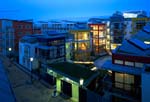 (Werner Huthmacher) The same view at night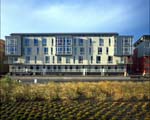 (Werner Huthmacher) The main (east) façade; ribbed pre-cast concrete panels on perimeter façades tie the building to the surrounding urban fabric.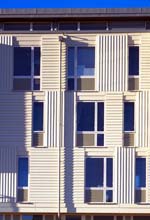 (Werner Huthmacher) A detail of the exterior façade; the concrete panels and triple-glazed windows create a syncopated pattern.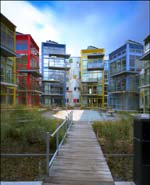 (Werner Huthmacher) Dynamic living room towers and vibrant colors frame the interior courtyard. Bridges connect units to the oval island in garden.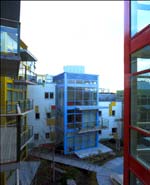 (Werner Huthmacher) Living room towers animate edge of garden.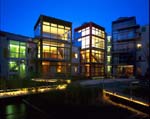 (Werner Huthmacher) In the evening the glass towers glow like lanterns.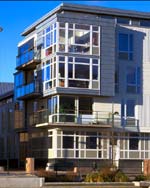 (Werner Huthmacher) Corner units feature bay windows.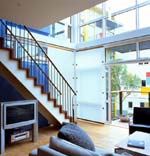 (Ole Jais) A living room opens up to the garden.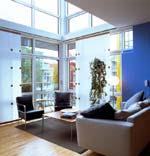 (Ole Jais) A light-filled living room in one of the towers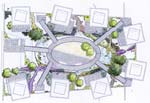 (MRY) Garden landscape plan (MRY) West elevation (MRY) South elevation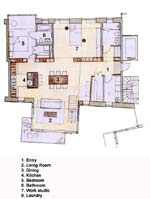 (MRY) A typical unit plan; no floor plan is repeated.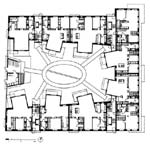 (MRY) Ground floor plan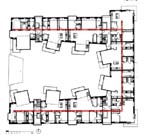 (MRY) Second floor plan shows "intelligent wall" for power and data cabling that runs through all units.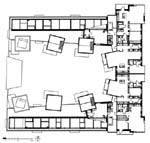 (MRY) Third floor plan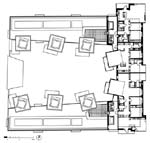 (MRY) Fourth floor plan |
© 2004 ArchNewsNow.com